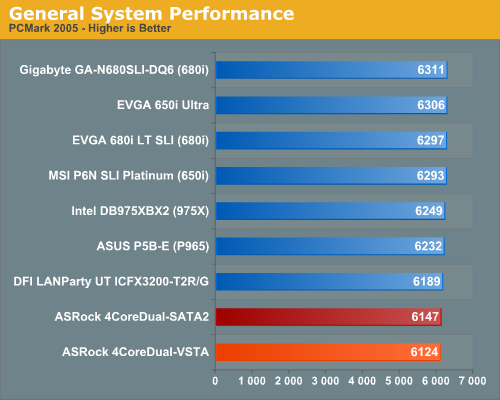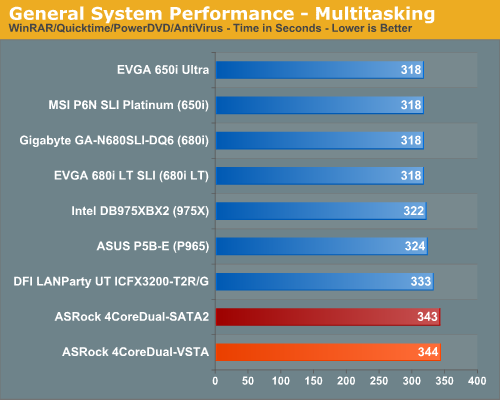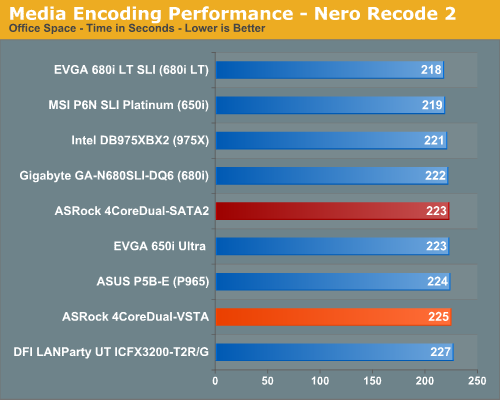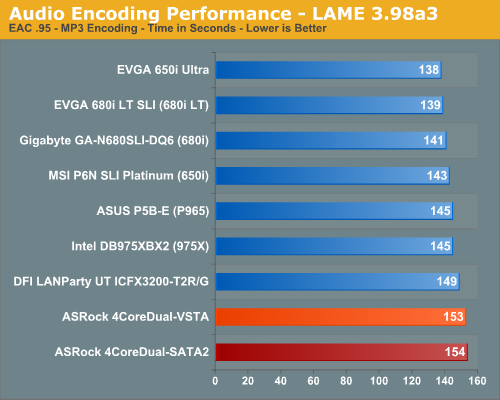ASRock 4CoreDual-SATA2: Sneak Peek
by Gary Key and Jarred Walton on June 29, 2007 6:00 AM EST- Posted in
- Motherboards
General System Performance
The PCMark05 benchmark developed and provided by Futuremark was designed for determining overall system performance for the typical home computing user. This tool provides both system and component level benchmarking results utilizing subsets of real world applications or programs. This benchmark is useful for providing comparative results across a broad array of Graphics, CPU, Hard Disk, and Memory configurations along with multithreading results. In this sense we consider the PCMark benchmark to be both synthetic and real world in nature while providing consistency in our benchmark results.

The performance range between the top board and our two ASRock boards is a minimal 3% with the primary difference in scores occurring in the graphics tests where the PCI Express bus is limited to x4 on the ASRock boards. The storage system and multitasking tests are also slightly lower than the Intel and NVIDIA solutions but it would take a benchmark to recognize the differences in actual usage.
We will have IPEAK results in our follow up article but a quick run of the PCMark 2005 HDD test suite had the 4CoreDual-SATA2 scoring 5840 and the 4CoreDual-VSTA reaching 5828, a difference of only 12 points. As far as we are concerned, the differences between Southbridges are minimal except for SATA 3Gb/s operation. Unless you are having compatibility issues with your SATA 3GB/s drives and the 4CoreDual-VSTA board, there is no reason to change boards.
General Application Performance
We devised a script that would compress our standard test folder consisting of 444 files, ten subfolders, and 602MB worth of data, convert a 137MB High Definition QuickTime movie clip to a 37MB MPEG-4 format, play back the first two chapters of Office Space with PowerDVD, and run our AVG anti-virus program in the background. We stop the script when the file compression and video conversion are complete. This is a very taxing script for the CPU, Memory, and Storage subsystem. We also found it to be a good indicator of system stability during testing.

The performance difference basically mirrors our PCMark 2005 tests with the Intel and NVIDIA chipset boards finishing at the top due to great CPU throughput, memory access, and multitasking performance. The main differences between the VIA based boards and the others is in the WinRAR scores where the ASRock boards performed terribly; we will see this more clearly in our standalone WinRAR benchmark. Removing the WinRAR test from this benchmark resulted in the VIA based boards finishing near the top in our video conversion test.
Media Encoding Performance
Our first encoding test is quite easy: we take our original Office Space DVD and use AnyDVD and Nero Recode 2 to copy the full DVD to the hard drive without compression, thus providing an almost exact duplicate of the DVD. We then fire up Nero Recode 2, select our Office Space copy on the hard drive, and perform a shrink operation to allow the entire movie along with extras to fit on a single 4.5GB DVD disc. We leave all options on their defaults except we disable the advanced analysis option. The scores reported include the full encoding process and are represented in seconds, with lower numbers indicating better performance.

We did not expect a strong finish from the two ASRock boards in this test based upon previous results. The spread between all of the boards is only 4% with our SATA2 board finishing in the middle of the pack. With CPU throughput and disk access times being the critical factors affecting test scores we expected these boards to have scored at the absolute bottom. In this particular test we noticed CPU throughput is slightly hindering the board's performance. We say this because the disk access time and transfer rate for the video files are among the best in our secondary tests measuring disk throughput - something which frankly surprises us.
Audio Encoding Performance
While the VIA chipset boards are competitive in our video encoding test, we wanted to see how they faired on the audio side. Our audio test suite consists of Exact Audio Copy v095.b4 and LAME 3.98a3. We utilize the INXS Greatest Hits CD that contains 16 tracks totaling 606MB of one time '80s hits. We set up EAC for variable bit rate encoding, burst mode for extraction, use external program for compression, and to start the external compressor upon extraction (EAC will read the next track while LAME is working on the previous track, thus removing a potential bottleneck with the optical drive). We also set the number of active threads to two to ensure both cores are active during testing. The results are presented in seconds for the encoding process, with lower numbers being better.

Our Plextor drive consistently takes two minutes and nine seconds to read all sixteen tracks. This means our test systems are only utilizing one core during testing until the midway point of the extraction process where the drive speed begins exceeding the capability of the encoder and requires the use of a second thread.
Unlike the media encoding section we see the ASRock boards scoring about 11% worse than the top boards in a benchmark where CPU and disk throughput are very important. Based on our previous results we would have to say that CPU throughput and memory access speeds negatively affected our two ASRock boards in this benchmark. While the differences are minimal in the overall scheme of things, it was clear during the test when both processor threads became active that the VIA based boards were definitely slower.
The PCMark05 benchmark developed and provided by Futuremark was designed for determining overall system performance for the typical home computing user. This tool provides both system and component level benchmarking results utilizing subsets of real world applications or programs. This benchmark is useful for providing comparative results across a broad array of Graphics, CPU, Hard Disk, and Memory configurations along with multithreading results. In this sense we consider the PCMark benchmark to be both synthetic and real world in nature while providing consistency in our benchmark results.

The performance range between the top board and our two ASRock boards is a minimal 3% with the primary difference in scores occurring in the graphics tests where the PCI Express bus is limited to x4 on the ASRock boards. The storage system and multitasking tests are also slightly lower than the Intel and NVIDIA solutions but it would take a benchmark to recognize the differences in actual usage.
We will have IPEAK results in our follow up article but a quick run of the PCMark 2005 HDD test suite had the 4CoreDual-SATA2 scoring 5840 and the 4CoreDual-VSTA reaching 5828, a difference of only 12 points. As far as we are concerned, the differences between Southbridges are minimal except for SATA 3Gb/s operation. Unless you are having compatibility issues with your SATA 3GB/s drives and the 4CoreDual-VSTA board, there is no reason to change boards.
General Application Performance
We devised a script that would compress our standard test folder consisting of 444 files, ten subfolders, and 602MB worth of data, convert a 137MB High Definition QuickTime movie clip to a 37MB MPEG-4 format, play back the first two chapters of Office Space with PowerDVD, and run our AVG anti-virus program in the background. We stop the script when the file compression and video conversion are complete. This is a very taxing script for the CPU, Memory, and Storage subsystem. We also found it to be a good indicator of system stability during testing.

The performance difference basically mirrors our PCMark 2005 tests with the Intel and NVIDIA chipset boards finishing at the top due to great CPU throughput, memory access, and multitasking performance. The main differences between the VIA based boards and the others is in the WinRAR scores where the ASRock boards performed terribly; we will see this more clearly in our standalone WinRAR benchmark. Removing the WinRAR test from this benchmark resulted in the VIA based boards finishing near the top in our video conversion test.
Media Encoding Performance
Our first encoding test is quite easy: we take our original Office Space DVD and use AnyDVD and Nero Recode 2 to copy the full DVD to the hard drive without compression, thus providing an almost exact duplicate of the DVD. We then fire up Nero Recode 2, select our Office Space copy on the hard drive, and perform a shrink operation to allow the entire movie along with extras to fit on a single 4.5GB DVD disc. We leave all options on their defaults except we disable the advanced analysis option. The scores reported include the full encoding process and are represented in seconds, with lower numbers indicating better performance.

We did not expect a strong finish from the two ASRock boards in this test based upon previous results. The spread between all of the boards is only 4% with our SATA2 board finishing in the middle of the pack. With CPU throughput and disk access times being the critical factors affecting test scores we expected these boards to have scored at the absolute bottom. In this particular test we noticed CPU throughput is slightly hindering the board's performance. We say this because the disk access time and transfer rate for the video files are among the best in our secondary tests measuring disk throughput - something which frankly surprises us.
Audio Encoding Performance
While the VIA chipset boards are competitive in our video encoding test, we wanted to see how they faired on the audio side. Our audio test suite consists of Exact Audio Copy v095.b4 and LAME 3.98a3. We utilize the INXS Greatest Hits CD that contains 16 tracks totaling 606MB of one time '80s hits. We set up EAC for variable bit rate encoding, burst mode for extraction, use external program for compression, and to start the external compressor upon extraction (EAC will read the next track while LAME is working on the previous track, thus removing a potential bottleneck with the optical drive). We also set the number of active threads to two to ensure both cores are active during testing. The results are presented in seconds for the encoding process, with lower numbers being better.

Our Plextor drive consistently takes two minutes and nine seconds to read all sixteen tracks. This means our test systems are only utilizing one core during testing until the midway point of the extraction process where the drive speed begins exceeding the capability of the encoder and requires the use of a second thread.
Unlike the media encoding section we see the ASRock boards scoring about 11% worse than the top boards in a benchmark where CPU and disk throughput are very important. Based on our previous results we would have to say that CPU throughput and memory access speeds negatively affected our two ASRock boards in this benchmark. While the differences are minimal in the overall scheme of things, it was clear during the test when both processor threads became active that the VIA based boards were definitely slower.










16 Comments
View All Comments
kings121 - Sunday, November 30, 2008 - link
hello can anyone tell me why the above mention grafic card cant work with the above mention motherboard?? or if it can....can someone tell me how to install the grafics card.........thankswaintin for a speedy reply
moobaaa - Tuesday, May 20, 2008 - link
hello anyone home still waitin to see the updated article thxs maybeppppp - Wednesday, January 9, 2008 - link
Hey guys,where is the updated review with the latest bios and Intel q6600 fsb you promised me some months ago?
kmmatney - Sunday, July 1, 2007 - link
I recently upgraded one of my systems to an As-Rock board with an E4400. Overclocking wasn't too bad - it could easily run the E4400 at 2.8 Ghz. However the boartd had weird quirks. It would not read my SATA HDD, which was the biggest issue. It also has trouble cold-booting, and the computer must be booted twice to start. Also, there are random trouble with a few old games (such as Red Alert 2) which will often crash, but run fine on my other systems. It's OK for a spare computer, but I wouldn't use it for my main rig. Also, the automatic speed control for the cpu fan has never worked right on my motherboard.ssiu - Friday, July 6, 2007 - link
Is your board 4CoreDual-VSTA, or other ASRock boards? (I am planning to get the E4400 and 4CoreDual-VSTA and overclock too.) Does it have the same problems at stock speed and/or 266FSB (that's the first thing I'd want to check, to see if the problem is related to overclocking)?vailr - Friday, June 29, 2007 - link
Re: "System Platform Drivers Intel - 8.1.1.1010".Shouldn't that be: VIA chipset drivers, instead of Intel?
Might also mention whether Win98SE can be installed and run, when testing with DDR/AGP? For those gamers dual-booting into the older Windows version. Can Win98SE utilize all 4 cores of a Quad-core CPU? Or even both cores of a dual-core CPU?
mongo lloyd - Friday, June 29, 2007 - link
Win9x has absolutely NO support for any kind of multiprocessor solution, neither dual/quad core, nor SMP.vailr - Friday, June 29, 2007 - link
Also, WinRar is currently at version 3.70:http://www.rarlabs.com/download.htm">http://www.rarlabs.com/download.htm
SunAngel - Friday, June 29, 2007 - link
ASRock has to joking. What tech person in their right mind is going to buy something half in the past and half in the future? The two SATA ports alone is enough to realize this thing will be outdated very quickly and you'll be buying another motherboard. I've seen some illogical products in my time. This may not be the worse concept of a motherboard for those not wanting to upgrade all their components, but there has definitely been some off-the-wall, fill-in-marketing-gap products out there (first thing comes to mind is the Intel Pentium D 805). Kudos to ASRock for taking advantage is cheapskates. Remember, it costs more in the long run doing the wrong thing (not upgrading) than doing the right thing (upgrading and moving forward with technology).ssiu - Friday, July 6, 2007 - link
This may not be the worse concept of a motherboard for those not wanting to upgrade all their componentsExactly; this board is good for those who want to carry over their DDR memory and AGP adapter from their old system. And it (at least its predecessor) can overclock a E2140/E2160/E4300/E4400 about 50%. If one has no need to reuse the memory and AGP adapter then I agree there are better choices (e.g. ASRock 1333FSB motherboards if one still wants to go cheap).